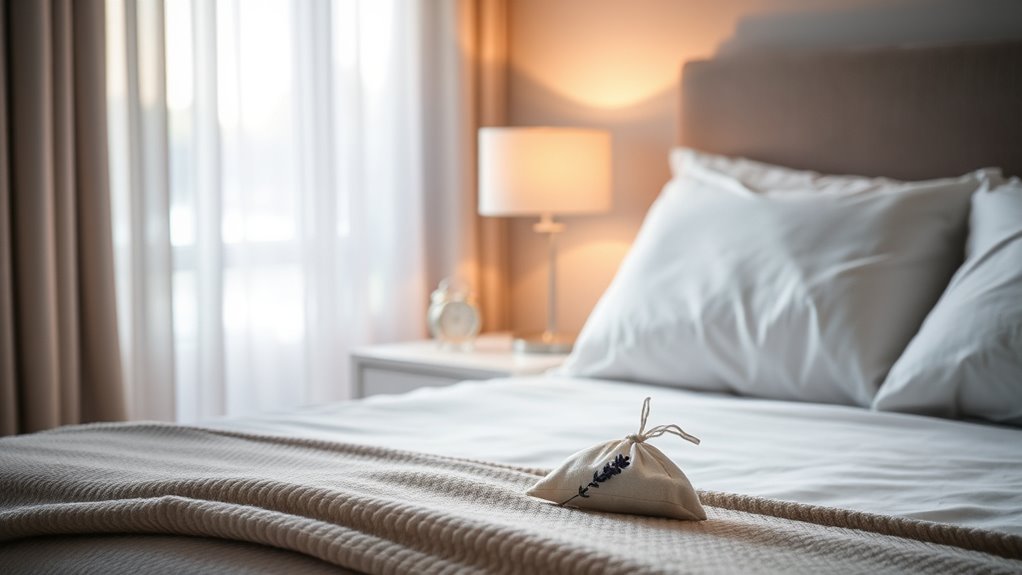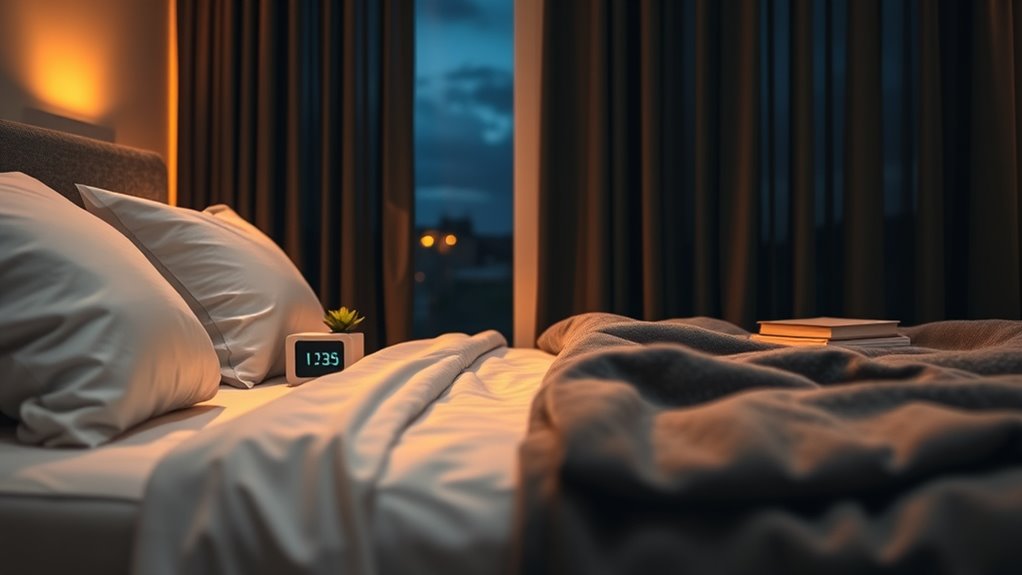In just 10 minutes, you can improve your sleep hygiene by creating a relaxing environment and establishing calming habits. First, make sure your bedroom is cool, dark, and quiet by adjusting your curtains, turning off electronics, and setting the thermostat between 65-68°F. Next, develop a consistent routine like gentle stretching or deep breathing, and avoid screens before bed. Keep it simple and focused—if you stick with these steps, you’ll discover more ways to enjoy restful sleep.
Key Takeaways
- Establish a consistent bedtime and wake-up time to regulate your internal clock.
- Create a calming pre-sleep routine, such as reading or deep breathing, to signal relaxation.
- Ensure your bedroom is dark, cool (65-68°F), and clutter-free for optimal sleep conditions.
- Avoid electronic screens and blue light at least 30 minutes before bed to promote melatonin production.
- Use blackout curtains, eye masks, and earplugs to minimize light and noise disturbances.
Quick Tips to Improve Your Sleep Environment and Routine

Getting quality sleep doesn’t have to take hours of effort. Sometimes, a quick 10-minute tune-up can make a huge difference in how well you rest. The first step is to focus on your sleep environment. Your bedroom should be a sanctuary for sleep—quiet, dark, and cool. Invest in blackout curtains or an eye mask to block out light, and consider earplugs if noise is an issue. Keep your room at a comfortable temperature, around 65 to 68 degrees Fahrenheit, since a cooler environment promotes better sleep. Remove distractions like electronic devices from your sleep space, as the blue light emitted can interfere with your ability to fall asleep. Instead, turn your bedroom into a calming retreat that signals your brain it’s time to wind down. Creating a calming sleep space can significantly enhance your ability to relax and drift off easily.
Next, your bedtime routines play a critical role in preparing your body for restful sleep. Develop a consistent pre-sleep ritual that signals to your brain it’s time to relax. This could include activities like reading a book, listening to calming music, or practicing deep breathing exercises. Avoid screens at least 30 minutes before bed because the blue light suppresses melatonin, the hormone that helps you fall asleep. Instead, opt for activities that promote relaxation, such as gentle stretching or journaling. Establishing a regular bedtime and wake-up time helps regulate your internal clock, making it easier to fall asleep and wake up refreshed. Even on weekends, try to stick to your schedule to maintain your body’s rhythm.
In just a few minutes, you can evaluate your sleep environment and bedtime routines to create a more sleep-friendly atmosphere. Take a quick walk through your bedroom and make sure it’s set up for ideal rest—dark, cool, and clutter-free. Then, spend a few moments winding down with a calming activity that you enjoy and that signals to your brain that it’s time to sleep. By making these small adjustments, you’ll reinforce healthy sleep habits and improve your overall sleep quality. Remember, consistency is key. These simple changes, done regularly, can transform your nights and help you wake up feeling more energized and ready for the day ahead.
Frequently Asked Questions
Can a Quick Sleep Tune-Up Replace Long-Term Sleep Therapy?
A quick sleep tune-up can’t fully substitute long-term sleep therapy, especially if you struggle with sleep myths or underlying issues. It offers immediate relief with relaxation techniques, but sustained improvement needs addressing root causes. Think of it as a boost rather than a complete solution. For lasting change, consider professional therapy, especially if sleep problems persist or worsen, to ensure healthier sleep habits long-term.
How Do I Know if My Sleep Hygiene Is Truly Improved?
You’ll know your sleep hygiene has improved when you notice better sleep quality and feel more refreshed and alert during the day. Pay attention to falling asleep faster, staying asleep longer, and waking up without feeling groggy. Consistently feeling energized and alert indicates your efforts are working. Keep tracking your sleep patterns, and if these improvements persist, it’s a sign your sleep hygiene is truly better.
Are There Any Risks to Trying Rapid Sleep Routines?
Trying rapid sleep routines is like planting a seed; it can grow quickly, but watch for short-term side effects like grogginess or disrupted sleep patterns. While they’re generally safe, there’s a small risk of dependency if you rely solely on these quick fixes. Stay attentive to your body’s signals, adjust as needed, and avoid overusing them to prevent potential dependency risks. Balance is key for lasting sleep health.
What Age Groups Benefit Most From a 10-Minute Sleep Boost?
You’ll find that age-specific benefits vary, but generally, children and teenagers benefit most from a 10-minute sleep boost, as it helps improve their sleep patterns and supports growth and development. Adults and older adults also see improvements in alertness and mood. Short, targeted routines fit all ages, but younger individuals often experience more noticeable changes due to their evolving sleep needs and patterns.
How Often Should I Perform This 10-Minute Sleep Tune-Up?
You should perform this 10-minute sleep tune-up daily, ideally at the same time each evening to reinforce your sleep schedule. Incorporate it into your bedtime routine to signal your body it’s time to wind down. Doing it consistently helps improve sleep quality, making it easier to fall asleep and stay asleep. Stick to this routine to maximize its benefits and develop healthier sleep habits over time.
Conclusion
By making small adjustments, you can transform your sleep space into a peaceful oasis. Think of your bedtime routine as tending a garden—consistently nurturing it will help your sleep flourish. Remember, a few simple tweaks, like a cozy environment and regular schedule, can turn restless nights into restful dreams. With just ten minutes, you’re planting the seeds for better sleep, so tend to your habits and watch your nights bloom with tranquility.










